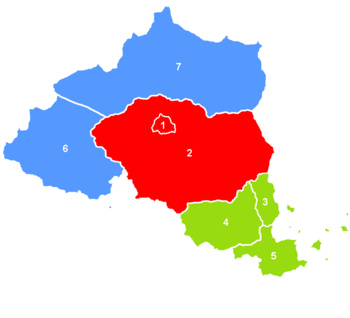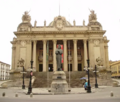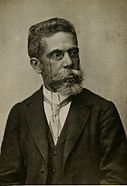Belmonte
Belmontese Republic República Belmontesa (Luzelese) | |
|---|---|
Motto: Non ducor, duco (Solarian) "I am not led, I lead" | |
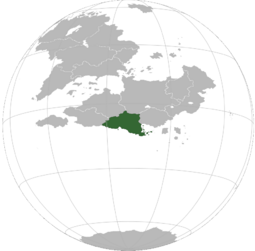 Belmonte (green) in Asteria (grey) | |
| Capital and largest city | |
| Ethnic groups (2020) | 41.3% White 40.2% Mixed 14.6% Black 2.6% Coian 1.3% Asteridian |
| Religion (2020) | 86.9% Sotirianity -67.4% Solarian Catholicism -19.5% Amendism 11.8% Irreligious 1.3% other |
| Demonym(s) | Belmontese |
| Government | Federal parliamentary republic |
| Caetano Villa-Lobos | |
• Premier | Rita Maurino |
| Legislature | National Congress |
| Senate | |
| Chamber of Deputies | |
| Independence from | |
• Declared | 07 August 1764 |
| 21 November 1771 | |
| 15 August 1764 | |
• Republic | 18 April 1792 |
| 06 July 1935 | |
| Area | |
• Total | 1,003,144 km2 (387,316 sq mi) |
• Water (%) | 0.5 |
| Population | |
• 2020 census | 36,334,190 |
• Density | 36.2/km2 (93.8/sq mi) |
| GDP (PPP) | 2020 estimate |
• Total | |
• Per capita | |
| GDP (nominal) | 2020 estimate |
• Total | |
• Per capita | |
| Gini (2020) | medium |
| HDI (2020) | high |
| Currency | Cruzado (BEC, ₡) |
| Time zone | UTC+13 (Belmontese Central Time) |
| Calling code | +57 |
| Internet TLD | .be |
Belmonte (/ˈbɪlˈmærˈtɪ/; Luzelese pronunciation: [bewmɔnte]), officially the Belmontese Republic (Luzelese: República Belmontesa), is a sovereign state located on the continent of Asteria Inferior, sharing borders with Nuvania to the west, Azure Coast to the east, Aucuria to the northwest and Satucin to the northeast.
It's known that the current Belmontese territory is inhabited by several indigenous peoples since 10,000 BCE, with Euclean colonization beginning after the landing of explorer Duarte Bórgia in 1503. In 1683, Belmonte was annexed by Poveglia in the aftermath of the Luzelese-Poveglian War and would be annexed again in 1721 to the Gaullican Empire, whose ill-treatment towards the local population served as the principal reason for its independence in 1764 amid the Asterian War of Secession.
Independence was recognized years later and a decentralized confederation was established. As republican and liberal ideas arose, the confederation was replaced by a federal presidential republic in 1792 after a short civil war. Tensions between liberals and conservatives led to a successful military coup which established a conservative authoritarian dictatorship, however, its inability to govern resulted in its overthrowing in favour of a parliamentary republic, with an oligarchic agreement allowing long-term stability. The breaking of the agreement years later caused large-scale political unrest throughout the country, resulting in another military coup which ceded power to far-right politician João Berquó, who ruled as a dictator for the next 20 years.
Belmonte was invaded and occupied by the Entente Powers during the Great War, its infrastructure completely ravaged and most cities destroyed, being only fully liberated at the late stages of the conflict. The end of the war made the democratic opposition gain support from large parts of the Armed Forces, which ousted Berquó and allowed the creation of the current democratic regime.
Belmonte is considered to be a developing country with an emergent economy, having a high HDI and a medium Gini coefficient, even though the country still suffers from alarming levels of poverty, social inequality, corruption and crime. Its political system is a federal parliamentary republic composed of six provinces and the Federal District. The legislature is the bicameral National Congress, which is composed of the Chamber of Deputies and the Senate. Its capital and primate city is Castelonovo. Belmonte is a member-state of the Community of Nations, the Asteria Inferior Common Market, the International Council for Democracy, the International Trade Organization and the Global Institute for Fiscal Affairs, among others.
Etymology
The word Belmonte is from both Luzelese and Vespasian origin and means "beautiful mountain." The most likely theory is that the name was first used to designate St Paul's Mount, which was the first piece of land seen by Duarte Bórgia's 1503 expedition, being officially adopted as colonization began years later. During the Gaullican period of rule in the region, its name was Gallicized to Beaumont, however, it saw few use by the majoritarian Luzo-Belmontese population, changing back to Belmonte once independence was achieved in 1764.
Before the arrival of Euclean peoples in Asteria Inferior, the several indigenous peoples present in Belmonte's modern territory, most of them from Tupi origin, gave two different names for the region: Apiraby - pointy land, referring to the region which is today the coastal provinces of Favônia and Laranjeiras, and Araxaiby - high land - further inland.
History
Pre-Asterian era
The oldest archaeological evidence about the presence of the homo sapiens in Belmontese soil dates back to 60,000 thousand years ago, but permanent human habitations only exist for 10,000 years. The indigenous population was based around tribes that had an extended knowledge of pottery cultures and had a complex political system based around the image of the tribe's leader, the cacique, and its religious and spiritual chief, the pajé.
Before the arrival of Duarte Bórgia's expedition in 1503, it is estimated that the indigenous population living in Belmonte was comprised of two million people, with the majority of them being part of ethnolinguistic groups: the Tupi-Guaranis and the Macro-Jês. These two ethnolinguistic groups are divided into the Tupis, Guaranis, Jês, Tupinambás and Tupiniquins, which, in turn, are subdivided into smaller groups based on local cultural and societal differences.
Regarding their expertise on the region they lived in, the natives knew extensively about their local fauna and flora and lived through the subsistence of hunting, fishing and gathering, with tribal boundaries being demarcated through war. Slavery was widely practised, although under a different meaning than the one used by Euclean powers, and religious rituals involving cannibalism were common. Religion was characterized by being polytheist with each tribe having its variations, while leadership was hereditary and decided among the tribe's warriors.
Colonial era


In 1503, after two failed attempts to colonize the Arucian, the Luzelese Crown decided to launch another expedition to the southern tip of the continent, led by explorer Duarte Bórgia. Bórgia's fleet, composed of 17 caravels, departed from Precea in January 1503, reaching St Paul's Mount near Pinheiros six months later on June 29th, with other expeditions being launched in 1506 and 1509.
At first, Luzela didn't have any interest in populating the area but, after Hennehouwe and Gaullica started to proclaim land nearby as theirs, the Crown established the first settlements in 1517, although true colonization only began two years later. In 1521, the colony became divided into captaincies and shared among the nobility, which was empowered as local governments. The colonization process was slow and costly, leading to further disinterest by the Crown who gave more powers to the captaincies and religious orders to act autonomously. As a result, the nascent Luzo-Belmontese population launched several independent expeditions called bandeiras and, over the years, colonial society was shaped and based around the bandeirante, contributing to the creation of an early Belmontese identity and people.
In 1683, after the Luzelese defeat at the Luzelese-Poveglian War, the country was forced to give Belmonte to Poveglia, which allowed the continuation of the Luzelese language and culture in the region. The aftermath of the Ten Years' War led to the annexation of Belmonte by Gaullica - unlike the Luzelese and the Poveglians, the Gaullican colonial administration was widely unpopular, fueling nationalist and illuminist movements. The harsh oppression and high taxes were the main reasons for the rural aristocracy with the support of the lower classes to declare independence in 1764, thus beginning the War of Belmontese Independence.
Soon after the declaration of independence, the revolutionary forces were organized into a single army under the command of General Sebastião Mascarenhas. The first years of the campaign were harsh for Belmontese revolutionaries due to the lack of equipment and experience, but the tides of the war changed in 1766 with the Battle of Humaitá, where Belmontese soldiers defeated a major Gaullican army. The war only ended with the Treaty of Vicalvi signed 5 years later in 1771, with independence being guaranteed by Gaullica and other major world powers. A confederation system of government was adopted, with Mascarenhas serving as its first Captain-Regent.
Post-independence
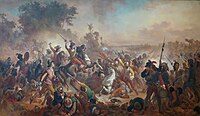
The confederation was characterised by its autocratic oligarchic regime ruled by slave traders and the rural elite, causing disaffection among many liberals and radicals influenced by illuminist ideas. In 1788, after state-sponsored crackdowns towards liberal and academic centres, a series of low-ranking officers mutinied against confederal rule, erupting into the Federalist Revolt. After 3 years of civil war, the Federalists, under the command of Jorge Aranha, won and abolished the confederation, establishing the First Belmontese Republic. Following a provisional government, the first elections were held, with Aranha becoming the country's first president.
Conservative inaptitude to attract voters and general hostility to the past confederacy and its conservative nature made Belmonte a de facto liberal one-party state. Further progressive policies led to total repulse from conservatives towards the democratic regime, leading to a military coup that successfully put conservative politician Joaquim Durão in charge. Durão's dictatorship was characterised by a state of perpetual unrest followed by violent crackdowns against the political opposition. By 1836, however, his position became unsustainable, and a revolution led by General Augusto Cintra overthrew his government and sent him to exile, establishing the Third Belmontese Republic.
To avoid the errors that led to the end of the First Republic, moderate conservative and liberal politicians met and created the Riachuelo Agreement, a political pact to ensure that their core interests would be protected, creating an rotative system where both groups always stay in power. A new constitution was drafted in the same year, establishing a parliamentary system and having Cintra as its first premier. The stability of the Riachuelo Agreement allowed the beginning of industrialization in Belmonte, which in turn led to massive immigration of Euclean and Coian peoples in the late-19th century.
The rapid transition of Belmonte to an industrialized society caused social strife and dissatisfaction towards the oligarchic regime. In 1913, the Belmontese Section of the Workers' International held both the presidency and premiership simultaneously for the first time and, combined with the Great Collapse, a military junta took power and closed Congress, establishing a military dictatorship. Claimed to be provisory, the junta abolished all political parties and cracked down on socialists and other left-wing radicals. Two years later, power was given through rigged elections to far-right politician João Berquó, who ruled as a dictator for the next 20 years. Berquó unified far-right and ultranationalist groups as his base of support and banned any opposition, establishing a cult of personality around himself.
Great War
Although the Berquó regime had various similarities with the functionalist powers, Belmonte declared its neutrality on the ensuing conflict but continued trading with both sides of the war. However, Belmonte's constant refusal to join the war as an Entente member, strategic geographical value and allegations of sending arms to the Aucurian National Redoubt Government led to Operation Palmier, the invasion of Belmonte by Satucin, Azure Coast and Nuvania, on February 7th 1932.
The Belmontese Armed Forces, which hadn't seen any combat since the end of the War of the Arucian, combined with the invasion day set at the height of Carnival festivities, were crucial factors for the fast movement of Entente troops through Belmontese soil. Three weeks after the initial attacks, Castelonovo was declared an open city and the government set a national redoubt at Paquatinga, with the entirety of the remaining army being relocated. In occupied Belmonte, an authoritarian collaborationist government led by Inácio Cohen was established by the occupying forces - soon after occupation began, a series of resistance movements erupted troughout enemy-controlled areas.
The first three years of the front were characterised by low-intensity battles and acts of terrorism and unrest against enemy forces, but this changed in 1933 when a series of strategic attacks against Nuvanian targets became a crucial factor for the removal of their troops. During the moving of Nuvanian forces, the government, in coordination with resistance cells, launched the Spring Offensive, leading to the total capitulation of the remaining of the Entente forces within Belmontese soil at the beginning of 1934.
Contemporary era
With the end of the Great War, Berquó's position in power became unsustainable as conservatives and liberals demanded a return of the oligarchic status of the Third Republic and the Armed Forces refused to maintain a dictator in power after spending years fighting the authoritarian regimes of the Entente. These groups, under the leadership of Júlio Lobato, decided to overthrow him in January 1935, with a provisional government taking place. A new constitution was ratified, and the Fifth Belmontese Republic, also known as the New Republic, was established.

During its initial years, the New Republic was dominated by the National Republican Union - initially a broad-tent party, the URN consolidated itself as a conservative right-wing party, being able to maintain itself in power for the next years under a heavy anti-councillist agenda, at the same time the country became embroiled with a series of far-left paramilitary insurgencies. It was only in 1969, after the murder of journalist Anderson Figlioli, that a series of protests caused the end of the 39-year URN dominance in national politics with a landslide victory for the oppositionist Democratic Front.
The 70s were engulfed in social and political turmoil amid a strong recession, resulting in an expressive victory of the left-wing Social Democratic Party (PDS) in 1979, its leader Félix Bragança remaining in power for eleven years - the longest premiership of modern republican history. It was only in 90s that the URN came back to power under Jorge Castelo, returning to the opposition in 1997 but gaining the premiership once again three years later, staying in power for the next 15 years. In 2015, the PDS came back to power under the leadership of Rita Maurino, who became the country's first female premier.
Geography
With 1,003,144 km2 (387,316 sq mi), Belmonte stands as the 5th-largest country of Asteria Inferior by area and is entirely under the UTC+13 time zone - also known as the Central Belmontese Time or more colloquially the Castelonovo Time. Its territory is entirely located in the Asterian Inferior continent, sharing borders with Nuvania to the west, Azure Coast to the east, Aucuria to the northwest, Satucin to the northeast and the South Asterian Sea to the south. Alongside its continental holdings, Belmontese territory also includes the islands of Santa Helena in the Juazeiro province and the Arquimedes Archipelago throughout Belmonte's western coast until the Masseau Shire at Azure Coast.
Regarding its topography, Belmonte is characterized for high terrain that is divided into three topographic regions: the Coastal Plains, the Central Highlands and the South Asterian Range. The Coastal Plains encompasses the coastal regions surrounding its coastline, with its height reaching 400 metres (1312 ft), while the Central Highlands occupies most of Belmonte's central holdings, with its transitionary areas closer to the Coastal Plains having elevations ranging from 400 to 800m (2624 ft) while further inland its height ranges from 800 to 2000 metres (6561 ft). The South Asterian Range is limited to the northernmost regions, with its general height always surpassing the 2000 metres mark.
Belmontese hydrography is centred on the Veracruz River, the largest river of Belmonte, followed by the Paraguaçu and Jaguaracambé rivers.
Tropical landscape at the Laranjeiras province coastline
Snow near São Leopoldo do Oeste at the Piratini province
The Veracruz River
Aerial view of a tropical rainforest in Pindarama, next to the Satucine border
Climate
Despite its small territory, Belmonte shows a large climatic diversity. The coastline has a mostly tropical savanna climate with wet and dry seasons of equal length, with smaller areas whose original biodiversity has been preserved presenting a tropical rainforest climate being scattered throughout the coast. Most of the country, however, has a humid subtropical climate, characterized by wet hot summers and cold dry winters, with higher points near the coast having an oceanic climate. The South Asterian Range has an alpine climate while the Juazeiro province along the Nuvanian border has the Caatiniga, a unique semi-arid climate influential on the culture and society of that region.
Generally, the hottest month of the year is January while the coldest is July. The hottest temperature ever registered was 41,7°C (107,6°F) at Itaé on January 13rd 1937, while the coldest temperature ever registered was -12,3°C (9,8°F) at São Leopoldo do Oeste on July 25th 1922.
| Climate data for Castelonovo, Belmonte | |||||||||||||
|---|---|---|---|---|---|---|---|---|---|---|---|---|---|
| Month | Jan | Feb | Mar | Apr | May | Jun | Jul | Aug | Sep | Oct | Nov | Dec | Year |
| Average high °C (°F) | 30.3 (86.5) |
27.4 (81.3) |
25.9 (78.6) |
23.2 (73.8) |
21.6 (70.9) |
20.1 (68.2) |
18.7 (65.7) |
19.2 (66.6) |
21.8 (71.2) |
23.9 (75.0) |
25.3 (77.5) |
28.2 (82.8) |
23.8 (74.8) |
| Daily mean °C (°F) | 26.7 (80.1) |
25.5 (77.9) |
23.3 (73.9) |
20.8 (69.4) |
17.4 (63.3) |
15.6 (60.1) |
13.6 (56.5) |
14.8 (58.6) |
16.7 (62.1) |
18.5 (65.3) |
21.1 (70.0) |
25.2 (77.4) |
19.9 (67.9) |
| Average low °C (°F) | 21.6 (70.9) |
19.4 (66.9) |
17.3 (63.1) |
15.9 (60.6) |
13.2 (55.8) |
10.5 (50.9) |
8.1 (46.6) |
9.7 (49.5) |
10.8 (51.4) |
13.5 (56.3) |
17.4 (63.3) |
19.3 (66.7) |
14.7 (58.5) |
| Average precipitation mm (inches) | 293 (11.5) |
278 (10.9) |
211 (8.3) |
184 (7.2) |
131 (5.2) |
98 (3.9) |
76 (3.0) |
83 (3.3) |
107 (4.2) |
134 (5.3) |
196 (7.7) |
237 (9.3) |
2,028 (79.8) |
| Average precipitation days | 19 | 18 | 18 | 13 | 12 | 10 | 07 | 11 | 12 | 13 | 17 | 18 | 168 |
| Source: Belmontese Meteorological Service | |||||||||||||
Biodiversity
When it comes to its biodiversity, Belmonte has been greatly affected by the destruction of its fauna and flora by human action, with the few reminiscing natural vegetation being limited to national parks and protected zones.
Over the coast, there is a large presence of seasonal tropical and mangrove forests, while over the Central Highlands mixed temperate forests are present and in the South Asterian Range alpine biomes are more predominant. The Caatininga region, located at the far west, is a xeric shrubland, being comprised of a dry and wet season. Belmontese fauna is mostly composed of small animals, whilst there is also the presence of pumas, jaguars, bush dogs and foxes.

Politics
Government
According to the Constitution, Belmonte is a federal parliamentary republic, with the President being the head of state and the Premier being the head of government. The executive is formed by the President, the Premier and their cabinet, the Council of Ministers.
The President is the highest-ranking officer in Belmonte and the commander-in-chief of the Armed Forces, being elected through the popular vote for a five-year term that could be re-elected once, having as advisory boards the Council of State (State Council) and the National Defence Council. Over history, the presidency's powers have been decreased considerably, with the post holding little to no influence over the national political framework currently other than being a cerimonial figure that acts at the consent of the premier and the National Congress.
The Premier is responsible for lead the Federal Government and the cabinet and is appointed by the president after general elections, being the leader of the party with the majority of seats in Congress. The premier needs parliamentary confidence to govern and must resign or declare new elections once this confidence is lost.
Legislative power is vested over the National Congress, which is the national legislature of Belmonte. As a bicameral parliament, the Congress is divided into the Chamber of Deputies and the Senate. The Chamber of Deputies is the lower house of Congress, being composed by 206 deputies elected for a renewable term of 5 years through a closed party-list proportional representation system. The Senate is the upper house, being composed by 35 senators elected through a single transferable vote system, with the role of representing all provinces and the Federal District.
Belmonte has a multi-party system, with various political parties exerting significant influence over the national political scene. The three largest parties are the centre-left Social Democratic Party (PDS), the centre-right National Republican Union (URN) and the left-wing Socialist Bloc (BS).
Administrative divisions
As a federation, Belmonte is divided between six provinces plus the Federal District comprising of the capital city of Castelonovo. The provinces are within major subdivisions called regions, subdivisions that, despite don't having any political power, were created to assist in the interpretation of statistics and help the Federal Government in enforcing regional policies. All provinces have its constitutions and governments, with the executive being lead by the province’s governor, the legislative by the legislative assemblies and the judiciary by regional courts. The second and lowest level of administrative divisions are the municipalities, which are led by a mayor and has as its legislature the municipal chambers.
|
|
Judiciary and law enforcement

Belmonte has a codified legal system based on the civil law, an Luzelese judicial heritage, and has as its magna carta the Constitution, which has been promulgated in 1935. Provinces and municipalities also have their constitutions, but they couldn't contradict federal law. The highest national court is the Supreme Court, which acts as a court of last resort and as a constitutional court. The legislation also allows the creation of regional courts to federal subdivisions, being subject to provincial law.
The Civil Guard is the law enforcement agency of the country, being under the responsibility of provincial governments with federal assistance through the National Public Security System. With 100,000 officers, the Civil Guard is one of the biggest law enforcement agencies of the Asterias and acts as a preventive, detective and forensic police force. Other law enforcement agencies are the National Force, which is under federal responsibility and is used in cases of national unrest to restore public order, and the Federal Police, which is responsible for combating crimes against federal institutions, drug trafficking, terrorism, organized crime and others.
The National Information Service is the national intelligence agency of Belmonte, being in charge of espionage and counter-espionage activities.
When compared to international levels, Belmonte has above-average levels of violence, with CON and ICD reports showing a homicide rate of 17 deaths per 100,000 inhabitants in 2019 and crime being considered a major malaise among society. Nonetheless, homicide levels have been slowly decreasing since the turn of the century. Currently, the Belmontese prison system is under a major crisis due to its overcrowding, having a shortfall of almost 100,000 accommodations.
Foreign relations
Belmontese foreign policy is based on the principles of non-interventionism and international cooperation with nations and foreign institutions, principles which have been in place since the establishment of the New Republic. Since the end of the Great War, Belmonte has as its most important allies Aucuria, the North Vehemens Organization and the Euclean Community, and has been a major sponsor of bigger integration among Asterian countries. Due to its opposition against South-South cooperation combined with support for Northern Powers, many specialists see Belmonte as a regional power due to its efforts of impending a Satucin-based hegemony in Asteria Inferior.
Currently, Belmonte is a member-state of the Community of Nations, the Asteria Inferior Common Market, the International Council for Democracy, the International Trade Organization and the Global Institute for Fiscal Affairs, among many others.
Military
The Belmontese Armed Forces are divided into three branches: the Army, the Navy and the Air Force. Together, they have a personnel of 175,000 people, both active and reserve soldiers, one of the smallest of Asteria Inferior. Conscription was officially disbanded in 1973 and is in no longer use since then. Since the last time Belmonte was invaded was during the Great War in 1932, the Armed Forces shifted most of its operations to counter-terrorist activities and humanitarian missions worldwide, being present in various CON-mandated peacekeeping missions.
Economy

Belmonte has a diversified, developing social market economy. According to domestic data, the national nominal Gross Domestic Product for 2020 was estimated at $577.2 billion, while the national Gross Domestic Product through Purchasing power parity (PPP) was estimated at $865.9 billion. The GDP per capita for the same year was estimated at $15,888 (nominal) and $23,832 (PPP), an increase compared to last year. The country has a workforce of 21.3 million inhabitants, an inflation rate of 3.7% and an unemployment rate of 2.1%. The biggest economic partners are the ASTCON and OAN, which has Belmonte as one of its members, and the Euclean Community.
In 2020, it was estimated that circa 56.3% of the national GDP comes from the tertiary sector, 33.2% comes from the secondary sector and the remaining 10.5% from the primary sector. Belmontese industrialization started relatively early when compared to neighbouring countries due to positive internal factors and heavy promotion by the State, seeing its height during the 1870s up until the Great Collapse. The Great Collapse, combined with the Berquó Regime and the Great War, effectively destroyed Belmonte's industry, with the country emerging as a post-industrial economy.
The Bank of Belmonte is the central bank of Belmonte, being responsible for the national economic policy, with the bank itself being ruled by a Governor appointed by the President under the consent of the Premier. The national currency is the Cruzado (₡). Other Belmontese important financial institutions are the Ipiranga Credit, the largest private bank in the country, the Bachelet Bank and Unibanco, while other important Belmontese companies, in general, are the Maynard Insurances, the Belmontese Airlines, A&P and the EPC.
Belpetro is the state-owned company that responsible for petroleum and gas production over Belmonte, being the only company allowed for the extraction, refinery and distribution of all petroleum and mineral gas within the country. In 2019, Belpetro produced an average of fifty thousand oil barrels per day.
Corruption is considered to be an endemic problem in Belmonte, seen by more than half of the population (63%) as the greatest problem that the country faces today. Corruption mostly happens on a local level, which makes it difficult to identify and contain it by federal agencies. Other major economic problems are high economic inequality and poverty, with most of the country's wealth still concentrated at the hands of a very minor yet powerful elite.

Energy
The entire Belmontese electrical grid is state-owned and managed by the CEBEL (Belmontese Electric Company in Luzelese). The overwhelming majority of the national electric grid is hydroelectric (73.8%) and mainly derives from the Veracruz and Paraguaçu rivers, with the three biggest hydroelectric dams being the Draco Cardoso Dam around Belojardim in the Favônia province, the Altocastelo Dam at Anchieta and the Iguaraçu Dam, also located in the same province. Together, they are responsible for almost half of the national electrical production.
Followed by hydroelectric energy comes nuclear power, whose development started in the late-60s. Today there are three nuclear power paints scattered throughout the country, the first of them, the Rebouças Power Plant, was inaugurated in 1976. While initial plans to expand the current nuclear electrical grid were proposed in 2012 and 2013, it had been cancelled by the social democratic Rita Maurino premiership as part of a coalition agreement with the Green Party.
Renewable energy has been increasing considerably over the years, with eolic energy being the most present in the country, mainly in the Juazeiro province. Solar stations also have been increasing amid the propitious tropical climate and high predominance of solar light over most of the year.
Other forms of energy production present in the Belmontese electrical grid comes from biomass, coal and petroleum.
Tourism

Tourism is one of the fastest-growing industries in Belmonte, with a report from the Federal Government estimating that around 2 million people visited the country in 2019, being one of the most visited countries of Asteria Inferior. Most of these tourists come from neighbouring countries, namely Nuvania, Aucuria and Satucin, but there also is a large presence of Euclean tourists, most of them coming from Etruria, Paretia, Gaullica, Estmere and Werania.
Natural landscapes are the most visited regions, combining ecotourism with entertainment and recreation at beaches and natural reservations, followed by urban tourism - Castelonovo is the most visited city, receiving 1 million tourists in 2017, most of it owing to its vibrant and eccentric nightlife, considered one of the best of the world, as well as its cultural festivals and expositions.
Religious tourism also plays a bigger presence, with several religious festivals over the year resulting in thousands of tourists every year.
Infrastructure
Transport

Primary Belmontese carriers of transport are the motorways, whose major development started amid the reconstruction of the country after the devastation left by the Great War (which destroyed all previous infrastructure) and was heavily promoted by the premierships of Júlio Lobato (1935-1942) and Cédrico Alvim (1945-1949), leading to the foundation of the National Motorway System (SNR in Luzelese) in the 40s. The first motorway built, the SRN-1, connects the capital Castelonovo to Ípsia through Riachuelo. While it used to be entirely state-owned, the system started to be partially privatized in the 90s and 2000s.
Rail transport used to be the primary method of transportation of cargo and passengers and saw its introduction to Belmonte in 1857, with the creation of the Castelonovo-Guararapes Rail Line. However, the Great Collapse greatly paralyzed the expansion of railways, and the Great War destroyed most of its tracks. Post-war, the government nationalized the remnants of rail infrastructure into the Belmontese Railways and rebuilt it in a much lesser scope, only serving and connecting major cities and limited to passenger transport. Nonetheless, recent years saw a push to expand the current rail extent, with new expansion projects being proposed and taking place.
There are five cities that have underground transit systems: Castelonovo, Riachuelo, Pinheiros, Ípsia and Belojardim, and several others that employ light rail, tram and tram-train systems.
Belmonte was a pioneer in regional air transport, being one of the first countries of Asteria Inferior to establish flight clubs and airstrips. The biggest airports are the Júlio Lobato-Castelonovo International Airport in Castelonovo, the Ararinhos-Pinheiros International Airport in Pinheiros and the Ricardo Alvim-Ípsia International Airport in Ípsia.
Hydric transport remains largely limited to regional transport around maritime communities next to rivers and the coastline. The biggest port is the Ípsia Port, managed by the Ípsia Maritime Authority, with its area of influence including almost two-thirds of the national GDP. Other important ports are located in Pinheiros and Julianópolis.
Healthcare

Belmonte's public healthcare system, the Public Institute of Social Care (IPSS in Luzelese), was established in 1947, making Belmonte one of the first in the Asterias to adopt a national public healthcare system, being maintained by the Federal Government, the provinces and the municipalities, with private systems taking a complementary role.
The IPSS is universal to all Belmontese citizens, with its service being maintained through an income tax. While its general condition has been improving over the years, it is still seen as largely defective, especially in rural and peripheric areas, with poor infrastructure and lack of medical professionals being the most common complaints.
Major health problems are cholesterol, hypertension, osteoporosis and Parkinson's, with the principal death causes being caused by ischemic heart disease, cerebrovascular disease, Alzheimer and lung diseases - all of them constituting the biggest challenges for both public and private health systems.
Another serious health problem is starvation and malnutrition which, despite numerous government policies and campaigns focused on its elimination, is estimated to affect almost 10% of the population. According to the government data, between 2017 and 2019, two thousand people died directly and indirectly because of hunger, while another study says that almost a quarter of the population is below the ideal weight because of poor feeding.
Education and science
Education in Belmonte is mandatory for everyone aged between six and eighteen years old and is mostly managed by the federal, provincial and municipal spheres, who are responsible for its organization and maintenance. The system is almost entirely public, with private schools being limited to the children of high-income families and religious institutions.
According to the 2020 census, around 4.2% of the population is illiterate, with this demographic being mostly confined to rural areas. Overall, the quality of public education is seen as satisfactory and has been increasing, however, it still is deeply rooted in social lines, with schools located in poor neighbourhoods or favelas having a lesser quality than those located in middle and upper classes boroughs.
Tertiary education is public but not mandatory, although highly encouraged. Major Belmontese universities are the University of Castelonovo, the Pontifical Catholic University of Castelonovo, the University of Alto de Santana, the Amendist University Reinford, the University of Riachuelo, the Polytechnic Institute of Pinheiros and the University of Laranjeiras, also being major scientific and research poles. Other scientific poles are the Bento Bernardes and Ítalo Pereira institutes, the National Space Technology Agency (ANTE) and the National Research Centre.
Among the members of the national scientific community, the most notable ones are: Bento Pascoal, Ricardo Eunício de Moura, Frederico Pacheco Dantas, Pedro Máximo Gama and Clemente Babineaux, along with Conrado Dumont, Flávio Pires and Jorge Schwartz.
Media

Written press was introduced to Belmonte in 1764 with the foundation of the Gazeta de Castelonovo, which served as the country's government gazette. After the Federalist Revolt, Belmontese press became freer, with several liberal-minded newspapers being created at the time. Although this was temporarily halted during the Durão Era, the proliferation of newspapers and magazines continued during the remaining of the 19th century up until the 1913 Coup. Although the 1935 Constitution declared freedom of speech a fundamental right, it remained tightly controlled by the consecutive URN governments of the time up until the 70s, when censorship was officially abolished.
Currently, the highest-circulating Belmontese newspapers are the centre-right Diário (also considered to be the national newspaper of record), the centre-left Republicano and the right-wing A Nação. Ever since the turn of the century, newspaper sales have decreased considerably, with many switching their focus to the rising digital scene.
Radio broadcasting started in Belmonte in 1921. In 1922, the state-owned Agency Belmonte was created, being the only allowed broadcasting company at the time. In 1939, premier Lobato expanded and reformed the agency into the Public Broadcasting Company (EPC), also being the first Belmontese television network with the introduction of television in 1950. Today, the EPC is the biggest and most viewed broadcasting company of Belmonte, being followed by the private-owned Excelsior Network and Tupi Television.
Demographics
According to the 2020 demographic census, Belmonte has a population of 36.3 million inhabitants, with a demographic density of 36.2/km2 (93.8/sq mi) and a ratio of men to women of 0.93:1. The population is overwhelmingly urban with 91,7% residing in urban areas, the majority of them under the Central Metropolitan Axis, one of the largest megalopolis of the Asterian continent comprised of the metropolitan regions of Castelonovo and Riachuelo, the first and second largest cities respectively, having a population of 14.7 million or almost half of the national population.
Belmontese population grew exponentially during the second half of the 19th century, with the arrival of immigrants and the beginning of industrialization causing a demographic boom - the first demographic census in 1871 reported a population of 3.4 million that went to 11.2 million by 1911. However, the 1906-1913 political crisis in Belmonte, rampant economic depression further worsened by the Great Collapse, the general instability of the Berquó regime and the destruction caused by the Entente occupation during the Great War made the population retract to 8.9 million by 1940, the year where the first demographic census since the war was conducted.
Post-war reconstruction resulted in another demographic boom, albeit slower and more steady, with the population reaching the 10 million mark once again in 1943 and the 20 million mark in 1957, with populational growth decreasing as the country becomes closer to complete its demographic transition.
Race and ethnicity
Belmonte is one of the most ethnically diverse countries in the globe as the result of intense contact and miscegenation between several ethnic groups over the centuries. In 2020, 41.7% of the population (about 15.2 million) identified themselves as White, followed by 40.3% (about 14.7 million) as Pardo, 14.6% (5.3 million) as Black, 2.6% (0.9 million) as Coian and 1.3% (0.4 million) as Indigenous.
White settlement to Belmonte is divided into two large migratory periods: the first period happened during the colonial era and saw the migration of mostly Luzelese colonizers, followed by smaller quantities of Esmeirans, to the newly-established Belmontese captaincies. Luzela's handover of Belmonte to Poveglia saw a limited influx of Poveglian settlers and, when Poveglia was forced to cede the colony to the Gaullican Empire, it saw few-to-no Gaullican migration at all. The second migratory period comprised the late-19th and early-20th centuries, where positive socioeconomic conditions attracted millions of Euclean immigrants.
Black migration to Belmonte was mostly forced in the form of slavery during the 16th and 17th centuries, followed by limited Gowsa immigration in the 18th century, contemporaneously with Coian immigration.
The large number of different peoples and ethnicities that arrived in Belmonte throughout the centuries made the country one of the most miscegenated in the world, with almost half of the population describing themselves as Pardo - of mixed descent. Within the Pardo population, there are several subgroups such as Cafuzos (resulting miscegenation between blacks and natives), Mulatos (whites and blacks) and Mamelucos (whites and natives).
Religion
Although a secular state, Belmonte still is a deeply religious country, with almost 90% of the population declaring to have a religion in 2020. Out of these, 87.8% follow the Sotirian faith, with 67.3% being Catholics, 19.4% Amendists and 1.1% Spirits. 0.6% of the population is adherent to other religions, while 11.6% declare to be Irreligious.
Catholicism has a long-standing influence in Belmontese culture, arts, politics and society, with all three colonial powers that dominated the region (Paretia, Poveglia and Gaullica) being deeply devout Catholic countries whilst the Church acted as a major pillar to the colonial society of the time. Several Catholic orders also had a large presence and influence over Belmontese soil such as the Jesuits, which were responsible for the forceful conversion of the majority of natives. Catholicism remained the official national religion after independence up until 1935, with the Constitution officially separating the Church from the State. Nonetheless, it remained a powerful factor in Belmontese politics, both to the political right and to the political left.
Amendism was brought to Belmonte amid the large migratory wave of the late-19th century, being introduced by Weranian, Gaullican, Caldish and Estmerish immigrants. The remaining religions are mostly of Bahian and Coian origin with their adherents being immigrants from these respective regions.
Ever since the late-20th century, Belmonte's Irreligious population has been sharply increasing, with most of its demographic being composed of younger people residing in large urban centres (namely Castelonovo and Riachuelo), with forecasts predicting continued increase as per international trends.
Language

Luzelese is the sole official language of Belmonte - a condition enshrined and protected by the Constitution - and overwhelmingly used (~99%) by the majority of the population, being the only Luzelese-speaking country of Asteria Inferior and one of the few in the world alongside Paretia and Ardesia. The Belmontese variation of the language, known as Belmontese Luzelese, evolved through the centuries amid Euclean, Bahian and native influences, creating a unique accent when compared to its Paretian and Ardesian counterparts.
Before the arrival of Euclean colonizers, the region was linguistically split between Tupi-Guarani and Macro-Jê languages, whose continued contact between Luzo-Belmontese bandeirantes led to the emergence of the Beltilic Language, a creole and franca language widely spoken between the majority of Belmontese native peoples. While it saw extensive use by the population during the 16th and 17th centuries, heavy persecution and forced assimilation of native peoples saw its demise and almost extinction in the following years, with its remaining speakers still fighting for official recognition and protection by the Federal Government.
There are several linguistical communities present in Belmonte, whose languages were introduced by immigrants and kept spoken by their descendants, characterised by the usage of their native tongues together with a heavy Luzelese influence, such as the Hunsrik and Veglian languages in the Piratini province.
Urbanization
Belmonte is an overwhelmingly urban country, with more than 90% of the population reporting to live in urban areas. The Castelonovo-Riachuelo Metropolitan Axis, also known as the Central Metropolitan Axis, comprised of the cities of Castelonovo and Riachuelo and their metropolitan zones, is the largest of the country, with almost half of the national population residing there. Followed by it are the Pinheiros Metropolitan Region and the Ípsia Metropolitan Region, standing in second and third respectively.
Largest cities or towns in Belmonte
Institute of Demographics and Geography (IDGB) | |||||||||
|---|---|---|---|---|---|---|---|---|---|
| Rank | Province | Pop. | Rank | Province | Pop. | ||||
 Castelonovo  Riachuelo |
1 | Castelonovo | Castelonovo | 4 388 284 | 11 | Julianópolis | Piratini | 677 452 |  Pinheiros  Ípsia |
| 2 | Riachuelo | Anchieta | 2 737 021 | 12 | Paquetá | Anchieta | 651 391 | ||
| 3 | Pinheiros | Juazeiro | 1 848 353 | 13 | Cabral | Anchieta | 528 182 | ||
| 4 | Ípsia | Laranjeiras | 1 449 926 | 14 | Piraty | Laranjeiras | 491 587 | ||
| 5 | Belojardim | Favônia | 1 207 661 | 15 | Leopoldina | Favônia | 381 054 | ||
| 6 | Imboporã | Pindarama | 945 328 | 16 | Carvalho | Anchieta | 266 103 | ||
| 7 | Praiabela | Favônia | 873 235 | 17 | Vila Real | Anchieta | 231 851 | ||
| 8 | São Bernardo | Anchieta | 781 027 | 18 | Guarapiri | Anchieta | 196 819 | ||
| 9 | Sabugosa | Piratini | 732 409 | 19 | Blenhein | Piratini | 170 231 | ||
| 10 | Cintra | Juazeiro | 691 834 | 20 | Irecê | Juazeiro | 168 432 | ||
Culture
Architecture

Belmontese architecture was largely inspired by Euclean trends throughout its history, only starting to develop its own variations after the Great War. During colonial times, Belmontese buildings were based on the baroque and rococo architectures and the concept of few external designs and heavily decorated interiors. Both forms were mainly used by the Church and Jesuit missions located there, becoming widely used by the civilian population at the time soon after.
The two genres remained popular until the second half of the 19th century, when it started to be replaced by neoclassicist and eclectic styles. During the late 1910s and early 1920s, eclecticism started to be slowly replaced by the Gaullican Art Noveau and Art Decó, but they were never truly accepted as mainstream due to the outbreak of the Great War.
After the war, many artists came back to Belmonte, starting the modernist movement of the country. Modernist architects such as Cláudio Bachlechner, Luís-Eustáquio Diniz and Margarete Saval became the most known architects of the time, being responsible for projecting numerous works during the reconstruction era between the late-1930s until the early-1970s. The URN-dominated government, although conservative, funded modernist art to present Belmonte as a contemporary country, causing a total rejection of previous architectonic styles during this period.
By the 1990s, postmodern trends started to achieve more predominancy, however, modernism still remains extremely influential, leaving a huge mark that defined a large fraction of the national cultural identity.
Music
Belmontese music is known for its diverse origin and influences that came from several parts of the globe. Classical music was brought by the Luzelese nobility and Jesuits, being initially of baroque and sacred origin. It was only after the Federalist Revolt that new orchestras and conservatories were established, with many composers transitioning to romanticism by the 1850s and 1860s. Romanticism started to be slowly replaced by more progressive and nationalist trends over the turn of the century, with this era being marked by the works of Maurício Sobral and Lauro Sotiras. After the Great War, classical music started to be influenced by more contemporary trends.
The first Belmonte popular manifestations were the Euclean-based modinhas and the Bahian-inspired lundus. Over time, both genres evolved into serestas and, when the country started to industrialize and receive immigrants at the beginning of the 1850s, foreign Euclean music and dance such as waltz, polka, xote and tango became widespread, with the junction of them originating the choro in the late 1880s and early 1890s.
From choro, samba was created at the beginning of the 20th century, becoming centred among black communities in Ípsia, with the genre founding its height in popularity during the 30s and 40s. As the 50s progressed, a new genre evolved out of samba - the bossa nova - which sought to add jazz elements to the music, creating a more urban sound. The genre found itself in the middle of international recognition in the 60s under the voice of Ricardo Alvim and his song The Girl from Atalaia. Together with other artists such as Lira Duarte and Olavo Farias, the rhythm reached worldwide popularity.
Inspired by the protests and revolutionary fervour of the late-60s, the tropinova movement and its subsequent genre were born, mixing folk, bossa nova and samba with a more psychedelic and tropical sound, having as its most famous singers Maurício Buarque, Jorge Mourinho, Eleonor Cruz and Gil Nkosi, while Guaxinim introduced rock n' roll to broad Belmontese audiences for the first time. The late 70s and early 80s saw the continuation of the popularization of rock music under post-punk and new wave influences, with bands such as Saturno, Excelsior, Longe das Capitais, Enfant, Arquitetos de Imágua and L'eau becoming widely popular. By the turn of the century up to present times, the Belmontese musical scene diversified, with the 2010s seeing a surge of indie rock, electronic, rap, trap and pop music.

Literature
Belmontese literature started with the consolidation of Jesuit missions in the colony, with the local literature, at the time influenced by religious dogmas, starting to shift into more baroque trends, however, it was only after the establishment of the First Republic that new schools of thought and artists appeared on the national scene. Baroque started to be replaced by romanticism in the 19th century and, over time, indianism was created, having a strong progressive and nationalist tone that promoted indigenous values and culture, having Aldo Paes's romances Tupi and Iandara as the subgenre's biggest works.
By the late-1870s and early-1880s, romanticism started to be substituted by realism, with the genre itself becoming widely known thanks to Gregório Assis and his books Bento and Obituary, leading him into universal acclaim as Belmonte's greatest writer. Realism continued to be the main Belmontese literary doctrine up to the 1930s with the proliferation of modernist and avant-garde movements in the country. By the 80s, the modernist school started to be replaced by postmodern trends.
Cuisine
Belmontese cuisine is influenced by Euclean, Bahian and indigenous cookery, being the result of the contact between these peoples. Before the beginning of colonization, the native population used the local fauna and flora as the base of their cuisine, largely consuming cassava, guarana and açaí. With the arrival of Luzelese colonizers in the 16th century, Euclean foods were added to the region, being adapted to the local climate. The introduction of slavery at the same time also led to Bahian peoples bringing their food to the forming Belmontese cuisine at the time, which evolved as more peoples from different cultures went to live there.
As the result, Belmontese cuisine is extremely diverse. Fish is the most eaten meat in the country, being present in moquecas and vatapás. Other consumed Belmontese foods are pão de queijo, mbeju, akara and beans - being consumed either as tropeiro beans, brown beans or feijoada. Belmonte also has a variety of sweets, with the most popular ones being the escurinho and bolo de rolo. The country's national drink is coffee whilst its national liquor is the cachaça, although wine is more consumed.
Cinema and theatre
Belmontese theatre had its origins in the colonial era, being brought from Euclean churches and monasteries by Jesuit priests to the newly-established colony. Catholic influence on theatre remained widespread until the 20th century when many theatrical schools started to be funded by the State and adopted a more secular position. Today, the scenario largely relies on the government to maintain itself but is extremely diverse and well-acclaimed by critics of all kinds.
The beginning of Belmontese cinema started in 1899, when the first projectors came from Gaullica, with the first cinema room being inaugurated in Castelonovo in the same year. The country's first movie, Panorama of Ípsia from the Lausanne, was only released a year later, being 3 minutes long. Although its introduction was greatly covered by the excited press at the time, its development was extremely slow, being only accessible to the urban elite due to its highly expensive tickets and difficulty of maintaining cinema rooms throughout the country.
However, this was promptly changed after the 1913 Coup and Berquó's accession to power. The dictatorship, suffering massive opposition in the early-20s, attempted to increase its popularity by controlling and funding the means of communication, including cinema, leading to the production of several propaganda films known for their nationalistic and overly patriotic nature.
The establishment of the New Republic in 1935 led to a golden era of cinema. With heavy censorship fading out, cinema production took a more commercial course as the country produced highly popular and lucrative movies, with famous actors of that time being Tina Bianchi, Arlete Sampaio and Lauro Lima. During the 70s and 80s, Belmontese cinema started to transition into a more underground period, being marked by the pornochanchada genre. Meanwhile, the 90s is known for its cult-esteemed films. To this day, Belmonte is one of the biggest movie producers of Asteria Inferior, leaving a large cultural footprint on the continent.
Visual arts
Belmontese art emerged in the 16th century, being entirely influenced by baroque religious themes followed by rococo trends after independence under the confederation era.
With the Proclamation of the Republic, the National Academy of Arts was created in 1819, establishing an academic period that took place over most of the 19th century. During its initial phase, the Academy only exclusively accepted Euclean arts such as neoclassicism and romanticism, having as prominent painters Hugo Bercout and Ulisses Braga. Nonetheless, it would in later years adopt indianism.
During the 1890s, both previous genres started to be substituted by realism and impressionism, with the movement being driven by Enzo Cinetti and Elisa Sampaio, becoming part of the artistic mainstream of the time. As the country's industrialization progressed by the beginning of the 20th century, the first modernist trends such as expressionism, fauvism, cubism and futurism started to be introduced in Belmonte, becoming extremely popular among the urban middle class, however, the ascension of the Berquó regime led to their rejection and persecution, with the country seeing the imposition of traditional and conservative artistic forms.
After the creation of the New Republic, many modernist artists who went into self-imposed exile returned to Belmonte, with painters Teresa Behamonte, Irineu Ricci and Rita Cavalcante organizing the Castelonovo Modern Art Week of 1937 which is seen as the founding moment of the modernist movement in the country. Unlike its predecessor, the URN government not only allowed but promoted modern art, which reached its height in the 50s and 60s. By the 80s, modernism started to be slowly replaced by postmodern trends, but remains an influential part of Belmontese history and culture.
Sports
Football is the most famous and practised sport in Belmonte, being an integral part of the country's culture. The Belmonte Cup and Primeira Divisão are the major national football leagues in the country, both of them organized by the Belmontese Football Confederation (CBF), with the Primeira Divisão being the primary and most competitive competition whilst the Belmonte Cup is its domestic counterpart. Followed by football, volleyball, basketball and autoracing also are very popular, having their competitive professional leagues and a large amount of media coverage and practitioners.
Water sports also have a large presence in Belmonte, especially swimming and sailing. Furthermore, the country has as its national sports footvolley (the combination of football and volleyball), futsal (indoor football) and beach football. Athletism, tennis, boxing, handball, rugby and hockey are also very practised among the population.

National holidays
| Date | Local name | Name | Observation |
|---|---|---|---|
| 1 January | Confraternização Universal | New Year's Day | Beginning of the year |
| 17 February | Dia da Liberação | Liberation Day | Liberation of Belmonte from Entente powers |
| 18 April | Proclamação da República | Proclamation of the Republic | Proclamation of the First Belmontese Republic |
| 1 May | Dia do Trabalhador | Labour Day | Tribute to workers |
| 13 June | Santa Catarina | Saint Catherine | Belmonte's patroness day |
| 7 August | Independência | Independence Day | Independence against Gaullica |
| 2 November | Finados | All Souls's Day | Day of remembrance of the dead |
| 25 December | Natal | Nativity | Major Sotirian celebration |





















